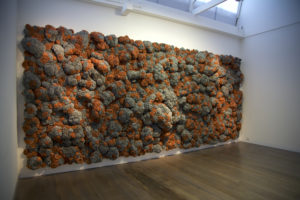Time is Measured in flour, pot scourers and green icing.
Deep in the basement of a Victorian building, a dark suite of chambers reverberates with low rumbling, interspersed with drippy squeaks. As if the subterranean hold for arcane Masonic rituals, various rooms e set up with suspended beds of flour at head height. Spotlights shine upon the dusty white underside and also the floor beneath, where the dour has filtered through and formed a mound. This installation by Sarah Duyshart turns the old building into a kind of hourglass that measures time as the loss of food. Meanwhile, the spooky sounds art extrapolated from recordings of the building itself, as if the heavy stony edifice — whose weight you experience oppressively in the basement — is a kind of ear, with lots of aural chambers and timpani, alas filled with sound- absorbing flour.
The absorption of sound and the passing of time are also evoked in Dani Marti’s work at Arc One Gallery, Time is the File in Which We Burn. The impressive tiftle is drawn from a 1937 poem by Delmore Schwartz, popularised through Star Trek.
Marti is well known for his large weavings of rope, impressive examples of which are in the current show. Tapestry is normally a slow art; Marti is able to speed it up by making his yarn exceedingly thick cable and keeping the patterns regular. These constructions also deaden the sound in the room .

The masterpiece (above), however, is a huge mural made from silver and brass-coloured steel pot scourers. These are batched in effusive clutches, as if growing organically like florid moss or lichen, with one layer overtaking the last. Their glistening efflorescence produces every shade, from sparkling highlights to deep shadow, and these tonal variations enhance the changes in hue , from cold steely grey to hot copper.
Individually, the pot scourers are prosaic, almost abject.
Designed for wounding an already damaged surface by grinding away the charred deposits of a burnt meal, they themselves wear out and become depressed and filthy. But in Marti’s spongy vertical garden, they remain forever elastic, escaping their former destiny.
Both soft and harsh, they seem to make a music that would deaden every other, as if you a could play Wagner in the next room and not hear a tuba blast through the absorptive abundance of netted filament.
Robert Nelson